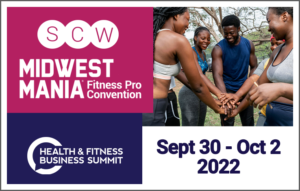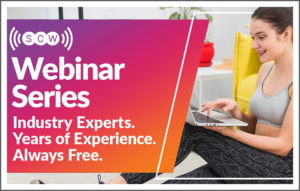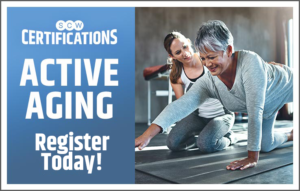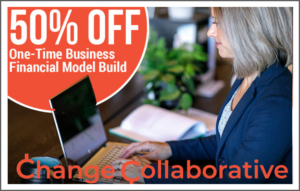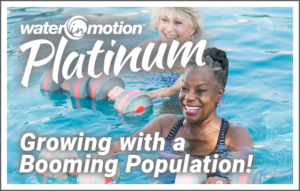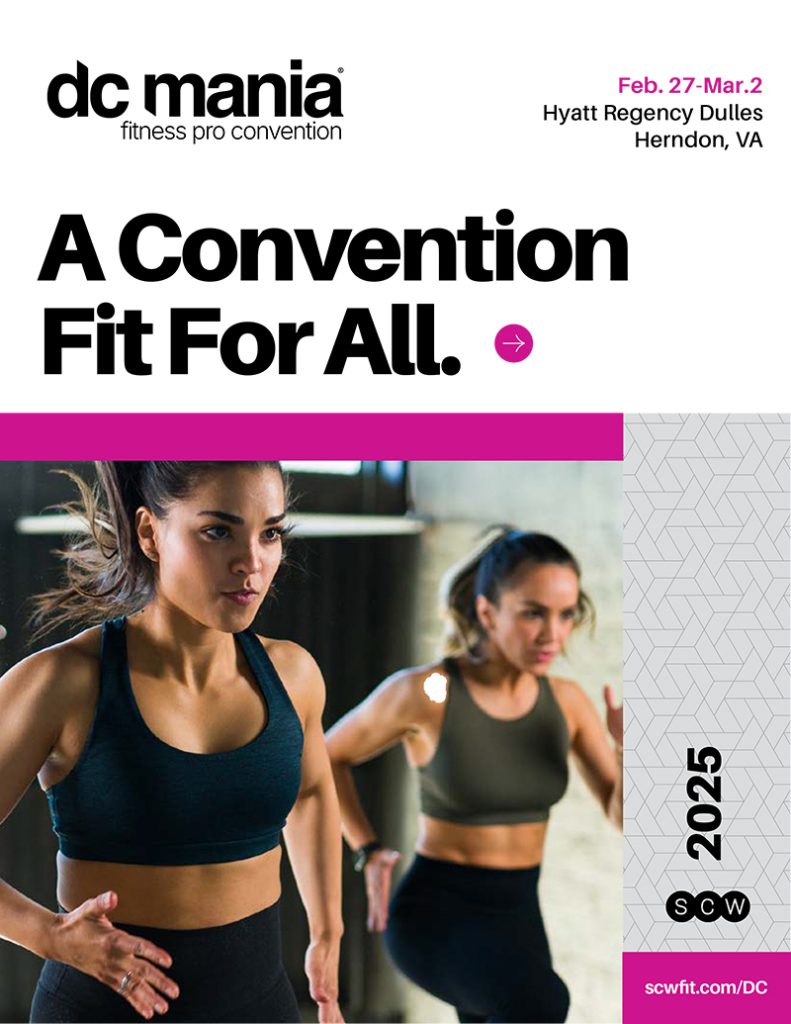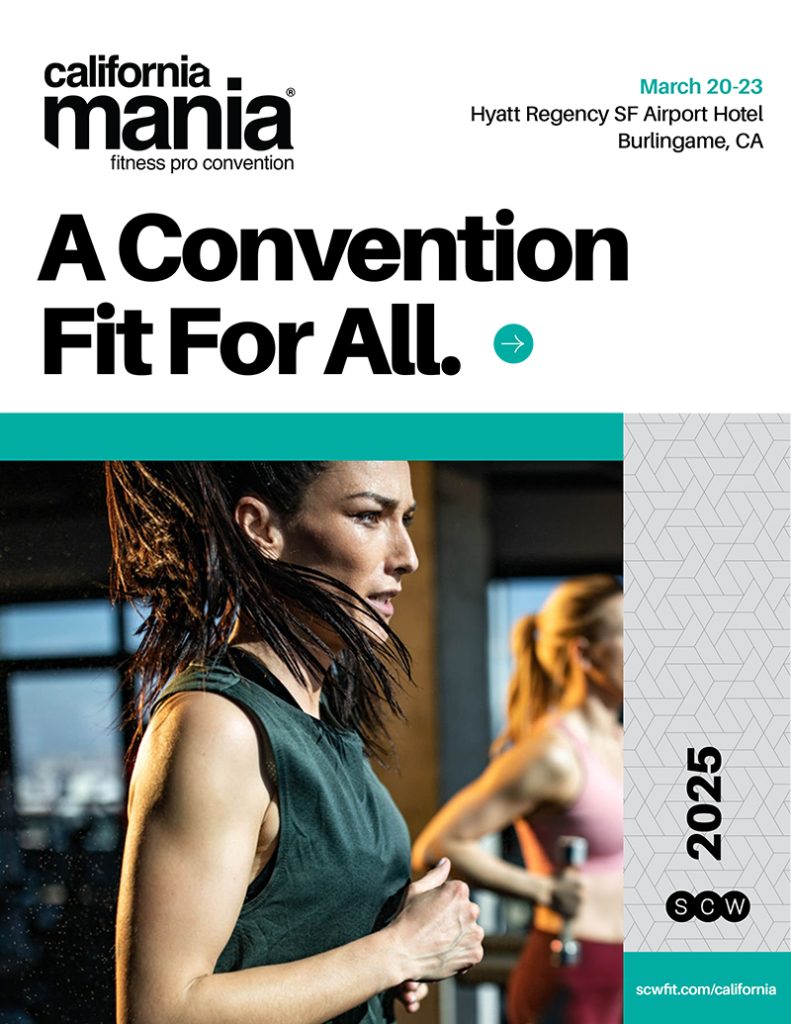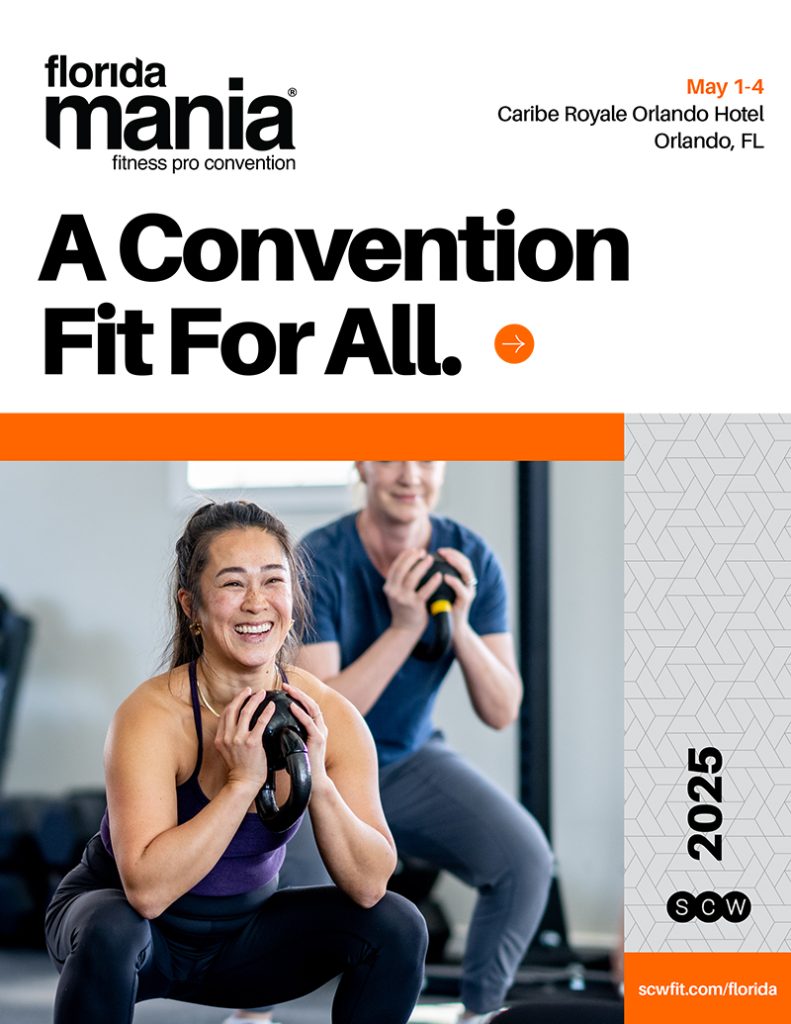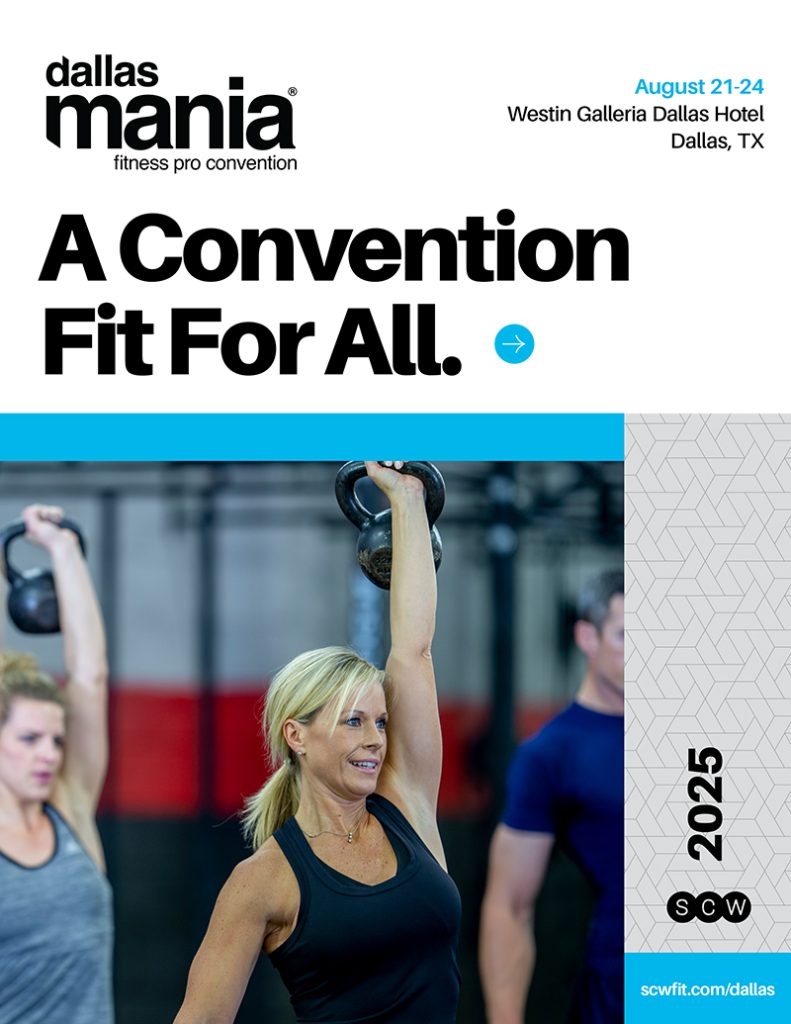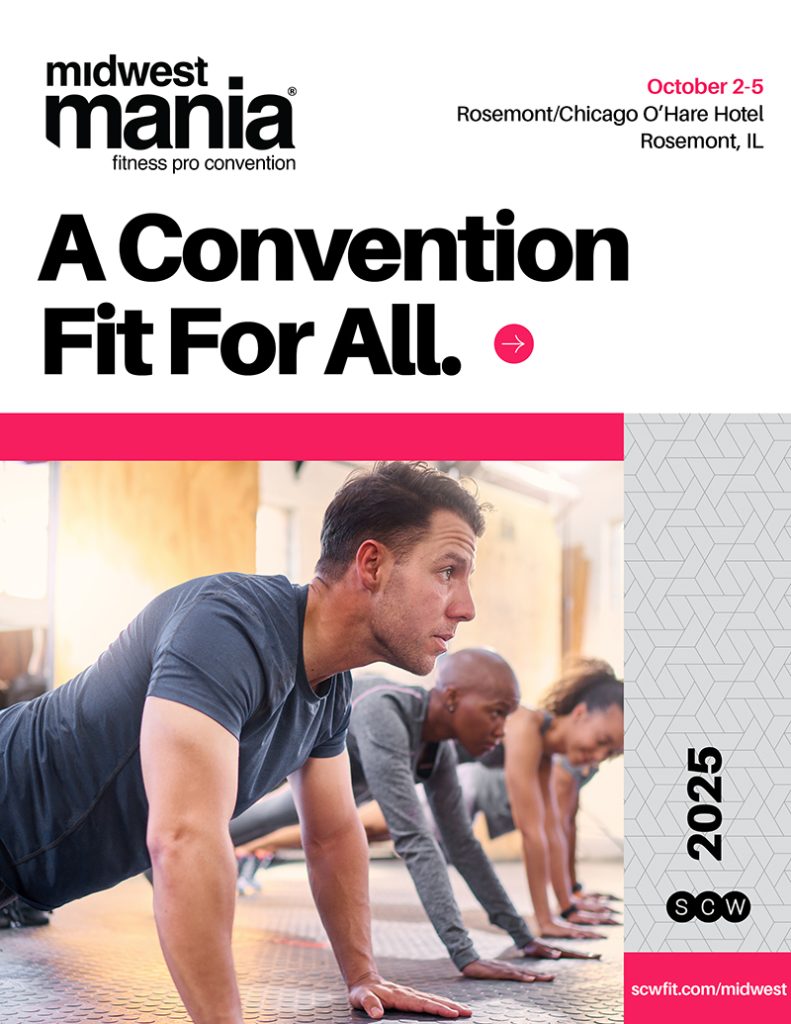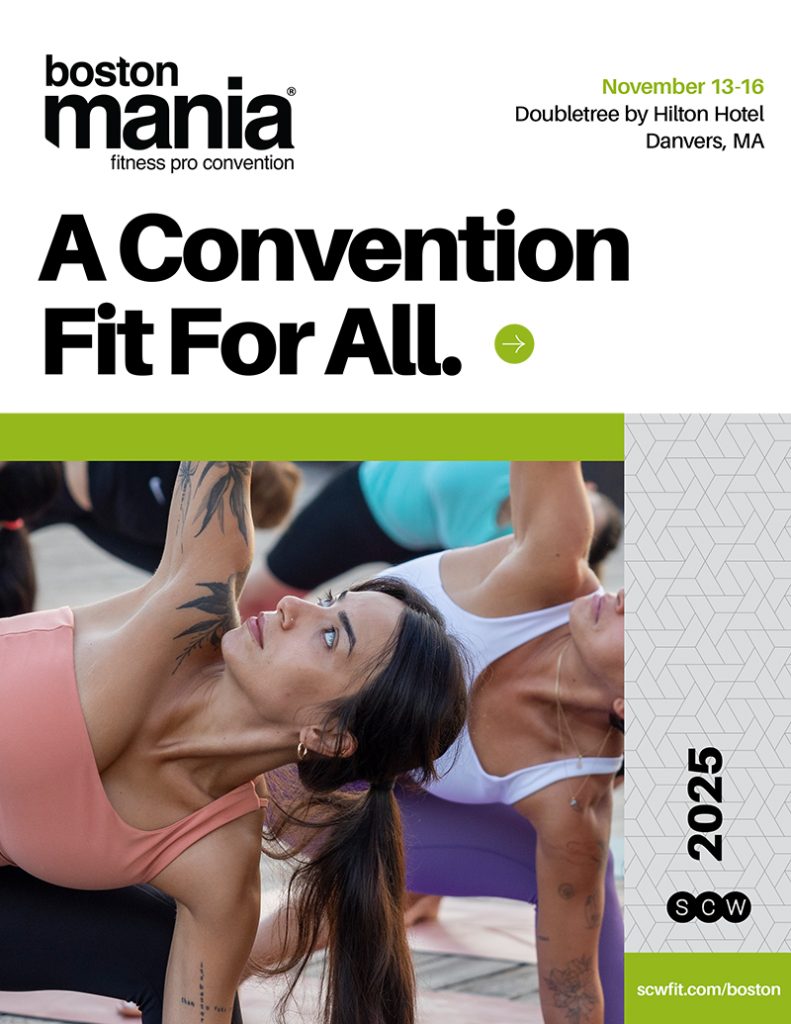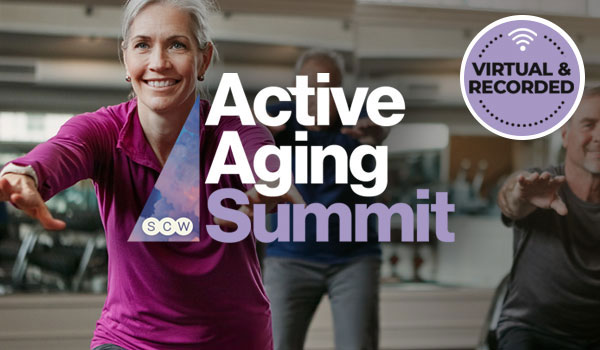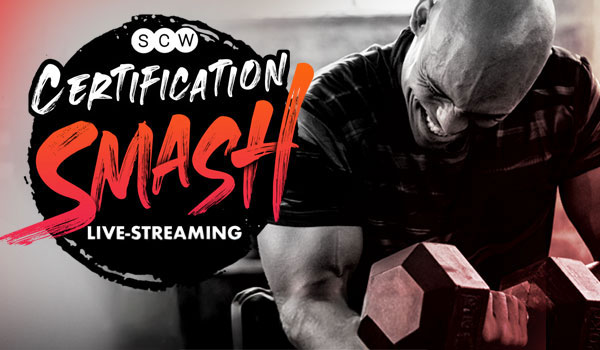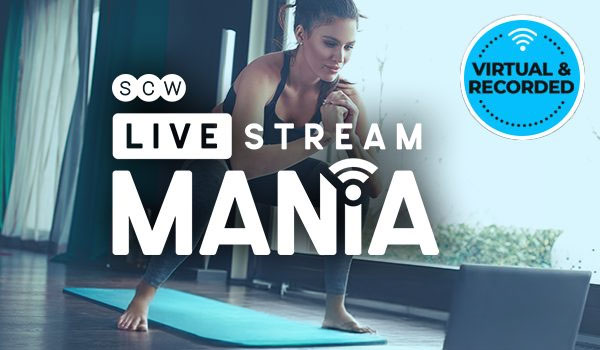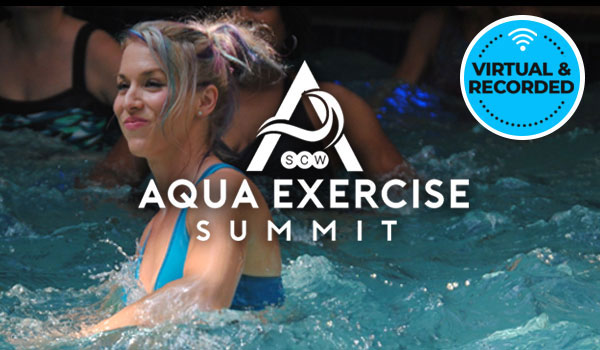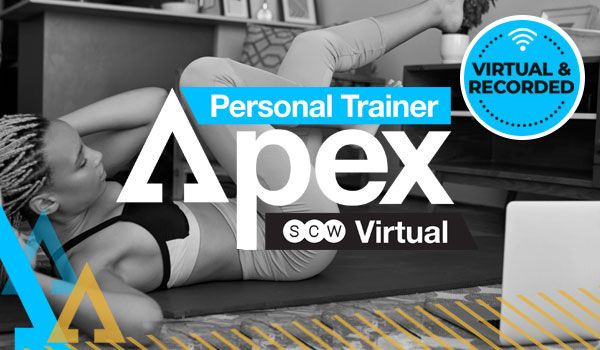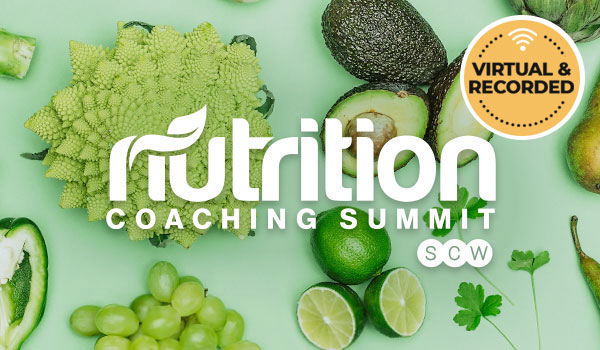
SCW Spotlite: Issue 50

Fall Prevention: It’s Not Just Physcial!
by Christine Conti, MEd
As a fitness professional or caregiver, what are you doing to help reduce the risk for falls? You may be reinforcing the importance of exercises that promote strength, balance, flexibility, and mobility, but are you aware that decreasing fall risk requires a multi-pronged approach? It’s time to reimagine what we know about reducing falls to better serve our clients of all ages and fitness levels.
Are you infusing these fall prevention best practices?
Proprioception
What is proprioception? It is the ability of your muscles and joints to determine where they are in space. The proprioceptive nerve endings in the body provide us with the information of where our hands, arms, and legs are in space without having to look at them. (What, 2022)
Proprioception results from sensory receptors in your nervous system and body. Most of these receptors are in your muscles, joints, and tendons, and when you move, the receptors send detailed messages to your brain about your positions and actions. Your brain processes these messages and works with your vision, nervous system, and vestibular system to create your perception of where your body is and how you’re moving. (Brennan, 2021)
As a fitness professional, it is important to address coordination and balance issues through various modalities when designing a movement session. For example, incorporating proprioception specific movements will not only reduce muscle deterioration, but also reduce risk of injuries from falls.
Have you tried these?
- Tai Chi or Vinyasa Flow Yoga can boost proprioception in the legs
- Seated or Standing Core exercises to increase balance
- Pushing & Pulling (compresses & stretches nerve endings) to increase stability
- Self-hugging and releasing, squeezing playdough, or touching fingers together for body awareness
- Stack objects like books and practice carrying them from one place to another
- Eyes Closed Prompted Movements: “Touch Left Elbow with Right Pointer Finger”
Brain Health
“In older people who had no signs of disease that would make them prone to falls, higher levels of activity in the front of the brain, called the prefrontal cortex, were associated with a higher risk of falls later in life.” (Brain, 2016) The prefrontal cortex, the area of the brain where goal setting and decision-making takes place, is just one part of the brain that has been linked to fall risk. These exercises help to light up the prefrontal cortex and other parts of the brain responsible for improving reaction time, coordination, and balance.
Dual-Tasking
- Add questions or engage in conversation
- Listen to Music with or without words
- Tell stories and ask comprehension questions
- Play “Alphabet” or various memory games
- Number exercises and call out numbers
- Right punch #1, Left punch #2, Right Kick #3, Left Kick #4
Hydration/Nutrition
In a 2015-2018 study by the CDC, “US adults drank an average of 44 ounces” of water, well below the recommended amount of fluid intake for a day. (Get, 2022) As a fitness professional, being aware of the risk for dehydration is the first step to averting it. While dehydration can have serious mental and physical consequences, it is important to know that it is both preventable and treatable.
Many people, especially seniors, resist drinking a lot of water because they worry about falling when possibly taking frequent trips to the bathroom. In fact, dehydration may even occur due to the fear of falling due to worrying about getting up multiple times at night. Whatever the reason, having an ongoing conversation about hydration should be built into your daily programming. (Dehydration 2021) You have the ability to ease their fears about increasing hydration to reduce falls.
Are you asking these questions?
- How many glasses of water did you drink today? Are you also drinking electrolytes?
- Do you frequently feel thirsty throughout the day? When?
- What other foods are you eating that contain mostly water? Fruits? Vegetables?
- Are you keeping a water bottle or glass of water near you throughout the day?
- What concerns you about adding more water to your daily routine? Falls? Why?
- Can you add more fruits and vegetables to your diet, so you stay hydrated longer?
Environmental
Perhaps one of the most important, and oftentimes overlooked, fall prevention best practice is analyzing one’s physical environment. (Buxton, 2021) Reminding clients about the hidden dangers and fall risks present in and around their home may significantly reduce falling and prevent life-threatening injuries. Creating an inventory of common environmental hazards is a great start!
Are you constantly asking them about their environment and how to make it safer? 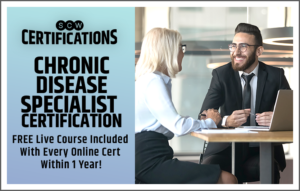
- What kinds of routine activities do you perform every day?
- Do you walk to the bathroom at night or rush to answer a phone call?
- Are there obstacles on the ground within the home environment?
- Pets? Small tables? Plants? Boxes? Shoes?
- Is their adequate lighting throughout your home?
- Nightlights? Hallways? Stairways? Outdoors?
- Are the floors and/or floor coverings slippery or could snag?
- Slick Flooring? Throw rugs? Thresholds?
In summary, knowledge is power, and consistency is key when it comes to fall prevention. While it is paramount to create safe and effective cardiovascular, strength, balance, and flexibility programs, it is equally important to address factors such as proprioception, brain health, hydration, and environment? The time is now to educate yourself to best help “fall proof” your clients!
If you are interested in learning more about this subject, join me at SCW Boston MANIA®, November 11-13, and register for the Fall Prevention Certification on Thursday, November 10.
Identifying potential fall risks, how to react and recover from a fall, and brain exercises are among the many focuses during this specialty program. Please reach out with any questions and find me on social media. www.ChristineConti.com, info@contifit.com, Instagram: @Christine_M_Conti, Facebook: Christine Conti, Twitter: @contifitness, YouTube: Christine Conti
 About the Author: Christine Conti, MEd
About the Author: Christine Conti, MEd
Christine is an Arthritis, Chronic Disease, Orthopedic and Fall Prevention Specialist, Best-Selling Author: SPLIT-SECOND COURAGE, Motivational Speaker, Podcaster, Conti Fitness & Wellness CEO, Consultant, International Fitness Educator, RA Warrior & IRONMAN.

Non-Science Skills Every Health and Exercise Pro Needs
While the work we do in the fitness industry is science and evidence-based, it is – at its core – people work. It is about the people we serve. A professional can be prepared with the scientific knowledge, skills, and abilities needed to do the job, but without those “human skills”, their success will be limited.
Here are the top 5 non-science skills every professional needs to take their career from surviving to thriving.
Interpersonal communication skills
We find ourselves in one-on-one situations with people throughout the day. This might be a meeting with a colleague, planning session with a supervisor, or sessions with clients. Whatever the situation, effective interpersonal communication skills are critical. It is imperative that we learn to actively listen, reflect, and clarify where needed. Too much gets lost in translation when we only listen with the intent to respond instead of to understand. Interpersonal communication happens face to face, virtually, and through writing (messaging, email, etc.). Take time to communicate openly, transparently, and clearly to those you interact with daily.
Emotional intelligence
Emotional intelligence or EI refers to the ability to recognize and manage your emotions and the emotions of others. This does not mean to mute or overlook emotions. This means to honor them – yours and those of others you work with (clients and colleagues). EI is also a part of communication. When emotions and feelings are not respected or honored, communication falls apart and rapport is drained. One of the biggest key components to EI is empathy – meeting clients where they are and coaching them in a positive direction forward. Emotional Intelligence by Daniel Goleman is an excellent resource.
Adaptability and flexibility
Clients run late, meetings run long, traffic delays us or issues arise at home. A plan is a great tactic to have but an even more valuable approach is to have it be a flexible plan, so you can adapt when called to do so. Similarly, if a client shows up for a session and their energy is low, that is a cue to you to change the plan. Instead of a hard-hitting weights session, maybe restorative yoga is in order.
Time management
In many ways, a fitness professional’s schedule is owned by those we serve. It is not a typical 8 a.m. to 5 p.m. job (necessarily). Learn to schedule your time wisely to still allow for mindful breaks, your own physical activity, and a transition period between sessions. This will help you avoid early career burnout and a waning interest in your job. I like to plan a 5-minute grace period on either side of a session to allow for those days where someone runs late (it happens even to the most organized individuals). Consider also adding a transition period between sessions so you have a chance to breathe, bookend your previous session with anecdotal notes and reminders, and prepare for the next client. Back-to-back sessions are killer on a person’s energy.
Conflict resolution
It is impossible to please everyone all the time. It’s part of human nature to experience conflict and disagreement. But there is an art to addressing concerns and resolving disappointment. As a professional, be prepared to have crucial conversations with colleagues and clients when the need arises.
While you continue your commitment to refining and growing your science-based components and skills, don’t forget to evaluate the softer side of your professional persona and identify areas of growth in the non-science category.
 About the Author, Dr. Erin Nitschke
About the Author, Dr. Erin Nitschke
Dr. Erin Nitschke is a professor of exercise science at Laramie County Community College. She holds certifications including NFPT-CPT, NSCA-CPT, ACE Health Coach, Fitness Nutrition Specialist, Therapeutic Exercise Specialist, and Pn1. Erin is an editorial author for IDEA, NFPT, where she writes regularly on topics related to personal training and health coach skill building, behavior change, and career success. Connect with her at erinmd03@gmail.com, @nitschkeerin on Instagram or on LinkedIn.

Balance & Power Training Active Aging Clients
by Ed Halper
For dear relatives and ourselves, we want mobility, independence, and good health in our later years. Genetics and good luck play a big part in that, but the SCW CEC Course, “Balance & Power Training Active Aging Clients” addresses things we can do at the gym and at home to help things along.
Given the fact that a few of you reading this article may be 50-plus with limited patience and attention span, here are some of the highlights of the course.
- The U.S. is 38th in longevity.
- Over half of our population is over 50 years of age, and 80% of that segment have one chronic health condition. 50% have two or more co-morbidities (a popular term over the past year-and-half.)
- There is a general 30% loss of muscle mass between 50-70 years of age.
- Even more thought provoking, having a 30% loss of strength and 30% loss of speed equates to a 60% drop in our body’s ability to produce power. (Think of an older baseball player with “warning track power” who also has problems “catching up with a fastball.”)
- To help remedy this issue, try to speed up your cadence in the concentric (start) of a weight-training exercise, and deliberately slow it down on the negative (finishing) phase. For example, on a bench press, power the weight up fast, and try to resist the weight on the way down (easier with a trainer or spotter).
- Generate power with rotational movements (think of a baseball or golf swing), but also strengthen your abdominal wall with isometric bracing like planks or simply holding a weight out in front of you.
- Getting off a chair or couch is a functional and increasingly challenging movement as we age. Practice it by going up and down 20 times at a rapid pace, preferably not holding on.
- Improve balance by standing or doing strength training movements on uneven surfaces, or with one or both eyes closed (have a spotter around for those.)
- Drink a lot of water and eat foods with a variety of nutrients to regulate blood pressure and sugar levels, and prevent dehydration, which can lead to falls.
- Try to exercise in a welcoming, friendly setting (like the gym or a park) to add that important social side. Fitness facilities provide more fun and increases your chances of sticking with it.
- Most importantly, don’t get caught up on what “you can’t do”. Accentuate the things you are capable of, don’t get down, and don’t give up. Let’s appreciate the fact we’ve reached our “Active Aging” years and make the most of it!
After you complete this CEC course, you may want to consider getting certified to train or teach Active Agers. SCW offers several highly recognized online certifications devoted to the 55+ population. All certifications include the course manual, outlines, instructions, online exam, and best of all the in-person live certification is free if you take it at a MANIA® Convention within a year. CECs are accepted from SCW, AFAA, NASM, AEA, ACSM, and ACE.
The SCW Active Aging Certification teaches cutting-edge research regarding aging and how to proactively become involved with our chronologically enriched clients. Focus on mental health, cardiovascular conditioning, strength training, flexibility, fall prevention, and balance.
S.E.A.T. Fitness is a turn-key solution for aging functional fitness. This brand new, unique 45-minute, evidence chair-based fitness program strengthens the body and mind, while improving balance and flexibility through functional fitness. Receive easy to follow choreography, music, flashcards, and more when you register for this one-of-a-kind certification. Click here for a video sample.
Hope you enjoyed this SCW CEC Course review, “Balance & Power Training Active Aging Clients” and it has inspired you to learn more about educating and working with the senior population. Stay tuned for the next review in an upcoming Spotlite newsletter.
 About the Author, Ed Halper
About the Author, Ed Halper
Ed has been a member of SCW since its inception, and currently holds four Certifications in Personal Training and Nutrition. He and wife, Laurie, were the proprietors of Mountain Fitness in Warren, NJ, from 1998-2018, and he still is employed at the site as a Fitness Trainer. Ed earned his B.A. from Monmouth College (now University) in 1980, where he participated in cross-country and track and served as head coach afterward. He pursued his love of fitness with a master’s degree in Education (concentration in Phys Ed) from Trenton State College (now College of NJ) in 1991. Ed, an active road runner with a marathon best of 2:43.06, has worked in the fitness field for over 35 years. He and Laurie are proud parents to two grown children, living in Washington, DC, and Boston. (The site of two SCW MANIA which give him a great reason to visit!) Ed’s fitness and nutrition articles can be found on the Mountain Fitness Facebook page. He can be reached directly at mntfit1@optonline.net

Tracking Metrics for Growth in Your Gym
by Katie Swanson, CPA, CVA
You know the metrics to track for members to help them reach their goals, but are you tracking metrics for your gym to get you closer to your business goals?
The 2022 Boutique Fitness Solutions State of the Industry survey results show the top two business challenges relate to growth. The number one primary business challenge for 26% of respondents is client acquisitions and the number two response for 21% of respondents is developing a growth strategy for their studio. Revenues have not recovered to pre-pandemic levels which makes sense why growth is the number one business challenge for studios and gyms.
We are going in depth with five key metrics related to the top health club challenge of growth. Setting targets, tracking, and taking action to impact the numbers will drive the growth of your gym forward.
To know how much you are growing, you need to be tracking member count. This seems like a no brainer, right? Having a goal of net new members per month will help you understand what actions need to be taken to make growth happen. Tracking member count seems simple on the surface, but this goes much deeper. It is important to understand all the parts of member count, which includes new and lost clients. You can also break down demographics by learning who your largest member base is and where hidden populations lie to increase membership. Peeling away layers of the onion will help you understand if your biggest challenge is client acquisition or client retention. If you can improve client retention, then client acquisition doesn’t become your biggest challenge.
- Revenue per Member
Growth strategy could include just increasing member count through client acquisition, but it doesn’t have to. Don’t forget about tracking Revenue per Member as part of your growth strategy. If you can increase your profit by increasing how much each client brings in, client acquisition isn’t your biggest business challenge. How do you know if this is a good growth strategy for your studio?
If your members are paying on average around $50 per month then increasing Revenue per Member may be a good strategy for you. Average monthly member price, per the 2021 IHRSA Media Report in 2019, was $52 which is 11% less than that in 2015 when adjusted for inflation. Certainly, if you’re charging around $50 per month increasing Revenue per Member may be a good strategy for your gym.
Increasing Revenue per Member most likely means providing more value to drive up this metric. Evaluate what is included in your gym membership, what ancillary products and services do you offer or could offer. In what way or ways can you increase the average members spend on all your products and services.
How often do you review class attendance, member experience, and class capacity? Let’s take this further and evaluate, based on your member count and average weekly member attendance, how many classes need to be on the schedule to serve your members. If you have more classes on the schedule than is needed to serve membership and provide the best experience, then you are spending more on payroll than necessary. Think about what number is the optimal class count for your member average weekly attendance rate and leverage this data to offer only the necessary classes to serve them best. Understand member patterns and behaviors especially during the summer.
- Payroll as a % of Rev
Payroll as a part of Revenue should be below 40%. If you don’t have employees and they’re all contract workers, consider those as payroll expense for this metric calculation. (I have seen this metric above 50%, but that was in a gym with a husband-wife ownership structure, and they were both pulling payroll equal to their highest paid trainer.) If this metric is creeping up take a look at your class schedule to see if there is room to reduce payroll by lowering the number of classes on the schedule. Where does your average wage stand?
- Cash Balance
Cash is like the number on the scale when you’re weighing your members. There is a healthy range on the scale of how much cash to have. If the number is too low, you’re running your operations too thin. If the number is too high, you are sitting on a bunch of fat and need to invest it somewhere. According to a JP Morgan Chase Institute analysis, half of small businesses don’t have enough cash to cover 27 days of expenses. What is enough for your gym? No one could have expected a pandemic and being closed for nine months, as California was, according to the 2021 IHRSA Media Report 2.2. If the cash isn’t sitting in your business accounts, you need to be able to liquidate or have access to cash to cover operations. What is enough? This depends on your comfort level. You can’t predict everything. 
No matter what growth strategy you implement in your gym these five metrics are key to tracking progress toward your goals. These and others are considered step four (Assess Against Benchmarks,) in my 5-step process for developing a business financial plan.
You can learn more about this unique process and much more during my presentations in the Business Summit at SCW Midwest MANIA®, September 30 – October 2 at the Westin O’Hare hotel. If you miss the presentation, stop by the Change Collaborative booth – I will be there all weekend and would love to meet you. Lastly, if you can’t attend Midwest MANIA® in person, over 100 session recordings are available for only $199 (was $299) or visit my website at www.changecollaborative.co.
 About the Author, Katie Swanson, CPA, CVA
About the Author, Katie Swanson, CPA, CVA
Katie Swanson is a CPA and Certified Valuation Analyst. She has almost 20 years of experience in corporate and public accounting and finance and as a fitness enthusiast. It is her mission to strengthen the financial core of gyms through business financial planning so they can move towards their goals with belief in themselves and their gym. She is the owner of the CPA firm Change Collaborative.

What is Aging Actively?
by Joy Prouty & Petra Robinson
We hear this statement all the time, “So what IS the strategy to achieve Active Aging?”
The concept of Active and Healthy Aging (AHA) is defined as the process of optimizing opportunities for health, participation, and security to enhance the quality of life as people age. The approach most often used to measure AHA is Rowe and Kahn’s Satisfactory Aging model from 2018.
So, first we must address the elephant in the workout room! Have you noticed that our fitness professionals are ‘aging’? Where is the next generation of fitness pros that will continue to grow and innovate the industry? YouTube???
Here we are, the ‘innovators’ in our day – yes, still relevant and creating programming, trainings, and helping our communities stay healthy. So, are WE, the older stateswomen/men of the fitness industry the poster children of “Aging Actively” And if so, WHY?
Well, we think it’s because of our love for fitness, dance, and sports which has been part of our lives from childhood through adulthood. So, where do we go from here? Will you and/or your students and clients be among the growing number of people who continue to live active and secure lives as we all age? And at exactly what age does this become important and a priority? What IS considered ‘OLD’???
Ask any group of 5 people when active aging is a priority, and you will surely get 5 different answers, depending on the age of those you ask! The quest, or plan for aging actively and well, happens long before a “certain age” – whenever that is! It involves the mind and body, the individual’s lifestyle, community, and to a lesser degree, your genetic makeup. 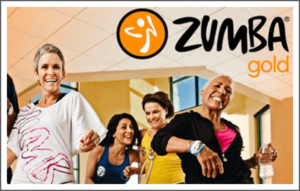
First, there is no shortage of research and information available to support the important “pillars” that identify the areas needed to optimize opportunities for health, participation, and security as people age. Second, we need to focus on things that enhance the quality of life; an active fitness lifestyle and social connections.
Research has shown that older adults identify with music and dance allowing them to enjoy the memories of their past, like going to discos, roller rinks, and dance aerobics classes, such as Richard Simmons “Dancing to the Oldies”, The Jane Fonda Workout, Jazzercise, and “Aerobic Dancing with Jackie Sorenson” to name a few.
Enter: ZUMBA Gold®!
The Zumba Gold® program is designed to bring the fun of the Zumba® Party. The energy of awesome music, dancing at all levels or skills, and the social aspect of connecting with others to build community. All this and more to bring quality of life to the aging community.
The actual Zumba Gold® class “checks” all the boxes and includes cardio, muscle conditioning, flexibility, and balance work all rolled into one. A big bonus is keeping the mind and body connected, and even fueling the brain! Just like a muscle, the brain needs to be challenged and engaged to stay strong. Learning, doing, and of course remembering the easy moves and choreography keeps the brain working without even “thinking” about it. It happens naturally! There is even a Zumba Gold® chair class, designed to provide an appropriate workout for the population with physical and/or psychological limitations.
Yes, physical activity is important for healthy aging. It can help seniors be more productive and active throughout the day, maintain a strong body composition, and avoid serious chronic diseases like diabetes or cardiovascular disease as they age. Even a small gain in muscle strength with the addition of balance exercises will help reduce their risk of falls later in life when mobility declines at older ages. The bottom line is the goal of Zumba Gold® is to help individuals age successfully, improve the quality of their life, all while providing a fun and enjoyable social environment!
The World Health Organization (WHO) provides several guidelines when it comes to physical activity. They include up to 60 minutes of exercise every day, performing intervals lasting at least 10 minutes each with two minutes of rest in between, and 20 minutes of moderate intensity exercise several days a week.
For healthy seniors, it is important to focus on exercises that target the body’s main muscle groups: the arms and legs. It is also vital they engage in activities that can be maintained over longer periods of time, so they don’t lose interest in healthy lifestyle changes.
Seniors who are socially engaged tend to be more healthy and physically fit than those who are lonely or isolated. Studies have shown how those who are 55+ and maintain healthy relationships with friends and family are less likely to succumb to diseases that cause physical disabilities or mental illnesses. From a healthcare perspective active aging helps to promote healthy living, and hence extend life expectancy and quality of life for all people (including those who are frail, disabled, and in need of care) as they age.
- Be kind to your skin. Your skin is your body’s largest organ.
- Exercise.
- Mind your diet.
- Mental health matters.
- Stay physically active.
- Lower your stress.
- Quit smoking and decrease alcohol consumption.
- Get enough sleep.
Click here for more information about Zumba Gold® and the Jump Start Gold Instructor Training. Use discount code TSZUMBA70 to receive 70% off any Zumba or Zumba Jump Start Gold training. Consider taking a live, in-person training at SCW Boston MANIA®, November 11-13 at the Doubletree Boston North Shore. With more than 150 workshops, including Zumba® sessions, over three days, this is an event not to miss. Hope to see you there!
Written By: Joy Prouty, Zumba Director of Education and Training and Petra Robinson, Zumba Fitness Industry Advisor

It’s Time to Suspend Your Training
by Karli Taylor
By now, I’m sure you have heard of suspension system training, right? Just in case you’re not entirely sure what I’m referring to, here’s a refresher. Suspension system training (SST) is a form of bodyweight exercise which uses an instability platform, consisting of straps and a pulley system, to leverage gravity into increased resistance.
People have been using various forms of suspension training for centuries, as images of gymnastics rings from the 19th century suggest. More modern SST have their roots in the military providing soldiers the ability to stay fit while deployed. Since they aren’t able to pack and manage large amounts of workout equipment, suspension system training allows them to quickly and easily set up and break down the equivalent of a gym to meet any level of fitness needs. The original suspension trainers used by the Navy SEALS were constructed from parachute webbing and rubber boat repair tools, but systems have come a long way since then! 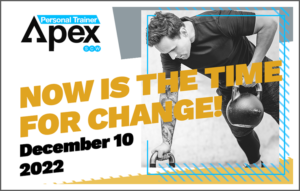
Though there are different forms of suspension training the predominating approach uses adjustable straps, attached to an anchor point to provide the perfect combination of stability and instability. The BareFit Suspension System has double density nylon straps, sturdy no rip handles, steel hardware, and padded foot straps for comfort built with the most rigorous athlete in mind. The no-scratch anchor system and high-density carabiners holds up to 900 pounds!
The BareFit Suspension System is an efficient tool for training major muscle groups in the body while also effectively targeting the core and stabilizing musculature. This powerful combination resulting from suspension system training is considered a promising activity for optimal muscle strength, mass, power, and functional performance.
Suspension system training creates an unstable environment that allows you to exercise multiple joints in multiple different directions. This is called multi-joint, multi-planar exercising. It relies on body weight, leverage, and gravity. For example, moving closer to the anchor point and/or spreading the legs wider will regress exercises, while moving further away and closing the distance between the legs will progress the difficulty. This unique piece of equipment allows you to customize exercises to meet the needs of each client.
Still not convinced that SST is for you? Let’s take a look at some of the benefits:
- Suspension system training has been proven to activate the core muscles far better than stable exercises done on the floor or on traditional weight training machines
- When used properly, suspension training can improve both strength and cardiovascular fitness.
- By simply adjusting the height and length of the straps, adjusting body positioning, or modifying stance can increase or decrease resistance or intensity. This makes suspension training appropriate for beginners and professional athletes alike.
- Promotes both mobility and stability – the balance between them helps the body move efficiently and effectively.
- At the retail price of $99, the BareFit suspension system is an inexpensive piece of equipment that can be easily set up nearly anywhere.
BareFit has developed a Suspension System Training Certification program that can be completed entirely online or in-person. The Suspension System Training Certification provides comprehensive instruction as well as a full library of exercises which can be modified for any fitness level. The course has been approved for CEUs through ACE, AFAA and NASM.
- Basic principles of exercise physiology
- Set up and use of the Suspension System
- Benefits of Suspension System Training
- Safety
- Exercise Selection
- Exercise Modifications
- Program Design
If you are interested in more information about the BareFit Suspension System, come check us out at SCW Boston MANIA®, November 11-13 at the Doubletree Boston North Shore Hotel. For a limited time, BareFit will be offering a 10% discount to all SCW attendees with coupon code SCWSST. If you would like to become certified to train clients using suspension, join our very own, Karli Taylor, for the BareFit Suspension System Training Certification on Thursday, November 10. MANIA® attendees can register for only $179 and purchase their own training system for only $49. What are you waiting for? Come get suspended with us!
 About the Author, Karli Taylor
About the Author, Karli Taylor
Karli is an award-winning international fitness educator who has been in the fitness industry for over 20 years. Karli is the creator and cofounder of BarreFlow, co-author of “Eating Disorders: What Fit Pros Need to Know” for the MedFit Network and creator of “Suspension System Training Certification” for BareFit. As a survivor herself, Karli is passionate about eating disorder awareness and about making fitness accessible and enjoyable for everybody.

Fall into Healthy Habits
by Amber Toole
As we prepare to say goodbye to summer and hello to pumpkin spice flavored fall, now is a great time to practice healthy habits and try out delicious, comforting foods.
If you are a pumpkin spice fan, like me, it’s easy to skip the sugar laden drinks and baked goods and swap them out for homemade treats. Making your own Pumpkin Spice Latte is cheap and easy! All you need is brewed coffee/espresso, milk of choice, pumpkin puree, pumpkin pie spice, cinnamon, vanilla extract, and sweetener of choice. Foam the milk, add pumpkin puree, spices, vanilla extract, and sweetener to your coffee, add milk, top with foam, and add a little sprinkle of cinnamon.
Pumpkin isn’t the only tasty winter squash. There are many other varieties you may want to try. Acorn, Butternut, and Delicata squash are delicious roasted and topped with a spritz of olive oil and a sprinkle of cinnamon. These are a great side dish to add to your favorite meal. You’ll get a dose of Vitamins A and C, plus fiber!
Colder weather makes some people crave warm, comforting foods. Making your own soup is a great way to bump up the nutrients and lower the sodium content. If you like pumpkin, try out a Pumpkin Chicken Chili recipe. Homemade soup loaded with your favorite fall vegetables, like kale, peas, celery, and cabbage, is an easy meal prep. Cook a chicken in the crockpot (also a great way to make your own chicken broth) or brown ground chicken or turkey to add to your soup and increase the protein intake. This will make your soup more satisfying.
Root vegetables are great to roast. Fall veggies like beets, Brussels sprouts, radishes, and potatoes make a great addition to any meal. They can be roasted and added to eggs for a hardy breakfast or mixed with rice or quinoa and your favorite protein source for a lunch bowl that travels well and is easy to take to work. For a healthy snack, pair a bowlful of of these tasty vitamin rich vegetables with a protein or a fat source (like hummus or avocado) and you have a snack that not only provides tons of nutrients but also satiety to keep your energy levels up and the afternoon slump at bay.
These colorful healthy treats aren’t the only items you can roast. In fact, you can create a one pan meal that makes cleaning up easy! Roasted Salmon, sweet potatoes and broccoli is one example. You get your Omega 3 fatty acids and a combination of carbs, fat, and protein all in one easy meal. Another delicious dinner is Turkey Stuffed Bell Peppers. Add in some rice, onions, and top with a dollop of Greek yogurt and a slice or two of avocado for another easy dinner that checks all the boxes for nutrients.
Take advantage of the fall crops and create new, healthy comfort foods to enjoy throughout the season. Make it a goal to experiment and try at least one new recipe each week. You just might surprise yourself with some new favorite dishes!
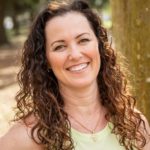 About the Author, Amber Toole
About the Author, Amber Toole
Amber Toole is an ACE Certified Personal Trainer with a Bachelor of Science degree in Physical Education and Health from Georgia Southern University. She has 30 years’ experience in the Fitness Industry and loves to share her experience with other Fitness Professionals. It is her life’s mission to spread the truth about fitness and nutrition through education. She is the owner of The Training Toole – a Fitness and Nutrition Studio in Ocala, Florida, an SCW Educator, and Fit Pro Mentor.
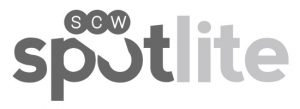 We’re always looking for great content highlighting the newest things in the world of fitness. Please submit your article directly to editor@scwfit.com for immediate consideration!
We’re always looking for great content highlighting the newest things in the world of fitness. Please submit your article directly to editor@scwfit.com for immediate consideration! Spotlite, April 16, 2025
Spotlite, January 5, 2025
Spotlite, November 11, 2024
Spotlite, September 27, 2024
Spotlite, August 31, 2024
Spotlite, July 26, 2024
Spotlite, June 22, 2024
Spotlite, May 23, 2024
Spotlite, April 26, 2024
Spotlite, March 22, 2024
Spotlite, February 19, 2024
Spotlite, January 20, 2024
Spotlite, December 21, 2023
Spotlite, November 18, 2023
Spotlite, October 22, 2023
Spotlite, September 21, 2023
Spotlite, August 19, 2023
Spotlite, July 19, 2023
Spotlite, June 19, 2023
Spotlite, May 18, 2023
Spotlite, April 21, 2023
Spotlite, March 28, 2023
Spotlite, February 18, 2023
Spotlite, January 21, 2023
Spotlite, December 16, 2022
Spotlite, November 19, 2022
Spotlite, October 22, 2022
Spotlite, September 24, 2022
Spotlite, August 23, 2022
Spotlite, July 22, 2022
Spotlite, June 20, 2022
Spotlite, May 18, 2022
Spotlite, April 20, 2022
Spotlite, March 25, 2022
Spotlite, February 17, 2022
Spotlite, January 14, 2022
Spotlite, December 17, 2021
Spotlite, November 18, 2021
Spotlite, October 25, 2021
Spotlite, September 16, 2021
Spotlite, August 9, 2021
Spotlite, July 10, 2021
Spotlite, June 8, 2021
Spotlite, May 14, 2021
Spotlite, April 30, 2021
Spotlite, March 30, 2021
Spotlite, February 23, 2021
Spotlite, January 20, 2021
Hyatt Regency Dulles
Herndon, VA
Hyatt Regency SF Airport
Burlingame, CA
Caribe Royale Orlando
Orlando, FL
May 1-4, 2025
May 2026
Grand Hyatt Atlanta Buckhead
Atlanta, GA
July 24-27, 2025
July 2026
Westin Galleria Dallas
Dallas, TX
August 21-24, 2025
August 28-30 2026
Rosemont Chicago O’Hare
Rosemont, IL
Oct. 2-5, 2025
Oct. 2-4 2026
Doubletree by Hilton
Danvers, MA
Nov. 13-16, 2025
Nov. 13-15, 2026

